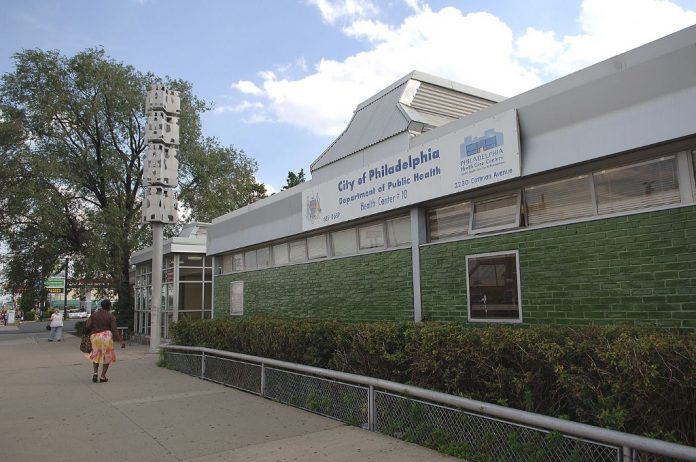The Philadelphia Public Health Center on Cottman Avenue.
Doctors who looked at the availability of medical care in the city have recommended building some kind of new primary-care facility in and around the Lower Northeast.
Currently, there are only a few that will treat uninsured city residents or people with Medicaid. There are thousands of Northeast residents with chronic ailments including diabetes and high blood pressure who are not seeing physicians, said Anje Van Berckelaer, who was one of the doctors who researched health care in the Northeast.
The city’s Health Care Center №10 at Cottman Avenue and Oakland Street, which does see Medicaid and uninsured patients, is so overtaxed that new patients must wait about eight months for an appointment, Philadelphia’s health commissioner, Dr. Donald Schwarz, said during an Oct. 4 session at Friends Hospital attended by about 50 people.
Before the meeting, the health commissioner said anyone who just walks into a health center will be seen but might have to wait all day.
Berckelaer, of Delaware Valley Community Health Inc., and Dr. David Grande of the University of Pennsylvania’s School of Medicine concluded that a new primary health-care center was needed after conducting a survey of the Northeast’s health-care needs for Healthy Philadelphia, a non-profit group.
They looked at the availability of primary health care in the Northeast’s 19111 and 19124 ZIP codes as well as in 19020. Their survey also led them to the conclusion that a new primary-care facility should be built somewhere in those three areas and that it should be convenient to public transportation.
Schwarz, speaking privately before the meeting, said such a facility would cost about $12 million, money the city doesn’t have and is not likely to get from the state or from the federal government. That would be the price tag without a “birthing center,” he said. Right now, there are no maternity wards in the Northeast.
The health commissioner said he was looking for partners in building a facility, but it is crucial that the community would welcome it.
The issue is more about where and only in part who, he said.
“I’m not going to plop a health center somewhere if people don’t want it,” he said.
Recent history might indicate some worries on that point.
Bustleton residents didn’t want a methadone clinic in their neighborhood. They came out in large numbers in early 2009 to oppose a plan to operate one, and, although there really were no legal barriers, local politicians lined up against it and the city withdrew the proposal. Right now, Holmesburg and Mayfair residents are battling a proposal to place a methadone clinic on the 7900 block of Frankford Ave.
Objections in both cases didn’t focus on the needs for the facilities, but rather on the fact that recovering drug addicts would be coming into the neighborhoods.
Not the same thing, Van Berckelaer said.
“I don’t necessarily see a health center as having the same negative image as a drug treatment center,” Van Berckelaer stated in an e-mail to the Northeast Times last week. “Having a health center near home is generally seen as an asset. A short walk or drive to your family doctor or pediatrician when your child is sick is far preferable to a long trip involving two or more buses.”
There is a definite need for more health care for people who live in and around the Lower Northeast, Van Berckelaer said during last week’s meeting at Friends Hospital.
And there is a mismatch between the care that now is available and the number of people who need it. Citing the study’s findings, which were first released last month, the doctor said:
The Northeast is home to about a quarter of the city’s population but has just three community health centers in its southernmost neighborhoods. (The researchers included 19020 in their study, which includes part of Lawncrest.) Health Center №10 is in ZIP code 19149.
There are 33 community health centers serving the remainder of the city.
The number of Philadelphians without medical insurance has doubled in the past 10 years as the population of the Northeast has become more diverse.
Across the Northeast, there are 18,000 people at high risk of not receiving the care they need, such as cancer screenings, blood pressure medicines or asthma treatments. Half those people live in ZIP codes 19111, 19124 and 19120.
There are 72,000 people in those ZIP codes who have at least one chronic disease such as diabetes, heart disease, asthma or high cholesterol.
In the Northeast, there are about 300 primary-care providers in 186 practices, but almost 40 percent of those providers don’t accept Philadelphia’s largest Medicaid plan. Those who do are concentrated in 14 percent of the practices, which include the already busy community health centers.
“The need here in the Northeast is real,” Schwarz said. “We want to try to figure out what to do about that.” ••
For more information about the Healthy Philadelphia survey of medical care in the Northeast, and about the non-profit group itself, visit www.healthyphiladelphia.org
Reporter John Loftus can be reached at 215 354–3110 or [email protected]





